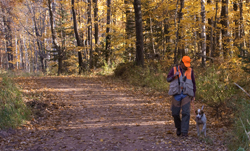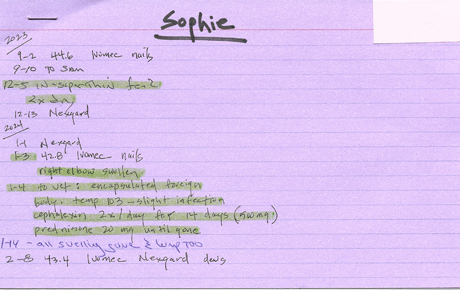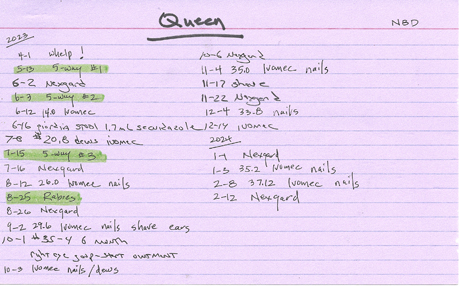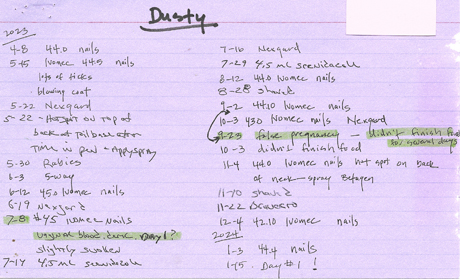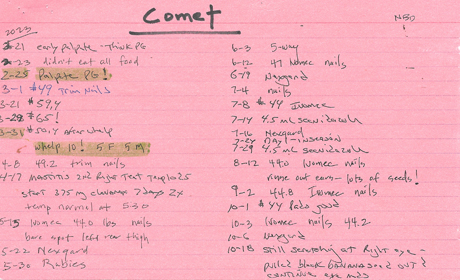Two key ideas for your dog’s health: dog care and dog log
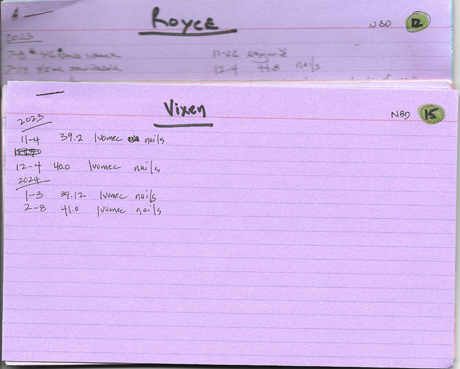
The dog cards for Royce and Vixen: Royce (age 10) now has 12 cards stapled together and Vixen (age 12) has 15.
There will be no admonition about the importance of a healthy dog in this post. Nor will there be finger-pointing about overweight dogs, a too-common issue.
Rather this piece is about performing a simple monthly routine and keeping track of your dog’s health. You might say, “I know all that,” but when questioned, you can’t remember when your female came into heat, mumbling “Sometime last August, I think. Or maybe July.”
Truly, Jerry and I know. For no matter the number of dogs you own, it is, practically speaking, impossible to remember all pertinent information regarding your dog’s health—from something as simple as whelp date to specific issues, vaccinations, injuries, surgeries and medications.
To accomplish this, we recommend monthly Dog Care for each dog and always keep a log.
Begin monthly Dog Care
On about the same date each month, set aside about 20 minutes for what we simply call Dog Care. This is a focused time to thoroughly examine your dog—independent from petting it while you read the newspaper after a hectic day.
• Weigh, using a scale.
• Check ears, eyes, inside mouth, teeth, paws, pads, toe nails.
• Feel body for scrapes, hair mats, ticks, other bumps and bruises.
• Trim nails and dew claws as necessary.
• Administer medications (heartworm and flea/tick medication) as necessary.
Keep of log—by dog—of all pertinent information
For each dog, Jerry and I use 8” x 5” heavy-duty index cards and staple the most current card on top. Vixen (age 12) has 15 cards now and Royce (age 10) has 12. A notebook kept by the kennel or in the feeding area could work. Creating something online could also be an option.
We record all health-related issues by date. (This should be easy because you’re now doing monthly Dog Care, right?) You can jot down weight, any issues and meds administered. Also note seemingly insignificant issues, such as vomiting or diarrhea. We also record trips to the vet, vaccinations and heat cycle dates.
Feeding amounts & weight issues (Sophie’s card)
Part of our monthly dog care includes weighing each dog. While we can usually catch weight issues—whether too thin or too heavy—by looking and feeling, weighing a dog is irrefutable evidence of a problem. If too thin, we increase amounts or feed twice per day. If too heavy, we cut back amounts or move to lower calorie food.
Trips to the vet (Sophie’s card)
For all trips to the vet, we note the diagnosis and any prescribed medications—including dosage and administration instructions. This information can be useful if the same problem occurs on the same dog or another dog.
Vaccinations (Queen’s card)
I know most people simply rely on their vet to track vaccination dates and send out reminder postcards but why not know exactly when your dog’s last Rabies vaccination was given?
Day #1 of heat cycle (Dusty’s card)
The is good information to note for short-range and long-range reasons. It’s important to get a feel for timing of your dog’s cycles and then be able to gauge when the next cycle will be. Too, since several of our females have had false pregnancies (symptoms include not eating well and swelling of mammary glands), the behavior is easily explained if it happens about nine weeks after Day #1.
Best of all….whelping dates (Comet’s card)
Jerry and I both agree that the best part of our business is whelping puppies. Even after more than 80 litters, we still are in awe when a dam whelps. It is at once miraculous, exhilarating and joyful. Log the whelp date and start a card for the litter.
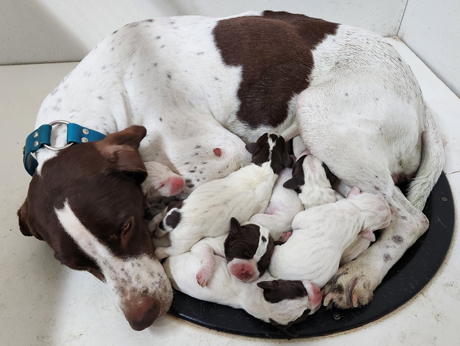
Northwoods Comet (HOF CH Rock Acre Blackhawk x Northwoods Vixen) with her one-day-old puppies by CH Southern Confidence (HOF CH True Confidence x Southern Songbird).
A couple final ideas!
1. Find a great vet and develop a great relationship. Bring the staff cupcakes. They are invaluable!
2. Be proactive about your dog’s health. Become familiar with recommended vaccinations, i.e., what is it really for and when does it expire. What is a “wellness exam” and does my dog really need one every spring?
3. A picture is worth a thousand words. Take a photo of a wound, injury or even a nasty stool. It could help in an emergency consultation with your vet or it could help track improvement.




